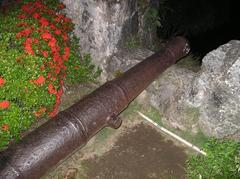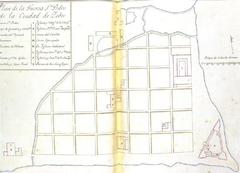
Fort San Pedro: Visiting Hours, Tickets, and Historical Sites in Cebu, Philippines
Publication Date: 18/07/2024
Introduction to Fort San Pedro
Fort San Pedro, located in Cebu City, Philippines, is a historical landmark that embodies the rich and tumultuous history of the Philippines. Established in 1565 under the command of Miguel López de Legazpi, the fort has witnessed the ebb and flow of colonial and wartime events. From its initial construction using wood and earth to its eventual transformation into a formidable stone bastion, Fort San Pedro has been a vital defensive structure against pirates, Moro raiders, and rebellious locals (source).
The fort’s strategic significance is evident from its triangular design with bastions facing both sea and land, ensuring comprehensive protection from potential invaders. Over the centuries, it has served multiple roles, including a military headquarters, a prison, and a hospital, reflecting its adaptability and enduring importance (source).
Declared a national historical landmark in 1946, Fort San Pedro is not just a relic of the past but a vibrant cultural hub that hosts events and performances, attracting both locals and tourists. Visitors can explore its well-preserved walls, underground tunnels, and a museum housing historical artifacts, thereby gaining a deeper understanding of Cebu’s colonial history and cultural heritage (source).
Table of Contents
- [Exploring Fort San Pedro](#exploring-fort-san-pedroexploring-fort-san-pedro)
- [Historical Background and Cultural Significance](#historical-background-and-cultural-significancehistorical-background-and-cultural-significance)
- [Spanish Colonial Era and the Fort’s Inception](#spanish-colonial-era-and-the-forts-inceptionspanish-colonial-era-and-the-forts-inception)
- [Transformation into a Stone Bastion](#transformation-into-a-stone-bastiontransformation-into-a-stone-bastion)
- [A Witness to History](#a-witness-to-historya-witness-to-history)
- [The Philippine Revolution and Beyond](#the-philippine-revolution-and-beyondthe-philippine-revolution-and-beyond)
- [Post-War Restoration and Recognition](#post-war-restoration-and-recognitionpost-war-restoration-and-recognition)
- [Cultural Significance](#cultural-significancecultural-significance)
- [Visitor Information](#visitor-informationvisitor-information)
- [Visiting Hours and Ticket Prices](#visiting-hours-and-ticket-pricesvisiting-hours-and-ticket-prices)
- [Accessibility and Travel Tips](#accessibility-and-travel-tipsaccessibility-and-travel-tips)
- [Nearby Attractions and Activities](#nearby-attractions-and-activitiesnearby-attractions-and-activities)
- [Conclusion](#conclusionconclusion)
- [FAQ](#faqfaq)
Exploring Fort San Pedro
Historical Background and Cultural Significance
Fort San Pedro stands as a silent sentinel in Cebu City, Philippines, its weathered walls whispering tales of a tumultuous past. More than just a tourist attraction, the fort is a living testament to the Philippines’ rich history and a symbol of the country’s struggle for independence.
Spanish Colonial Era and the Fort’s Inception
The fort’s story begins in the 16th century, shortly after Ferdinand Magellan’s arrival in the Philippines in 1521. Although Magellan’s expedition marked the beginning of Spanish colonization, it was only in 1565, under the command of Miguel López de Legazpi, that the Spanish established a permanent presence in Cebu. Legazpi, recognizing the strategic importance of Cebu as a trading hub, ordered the construction of a fort to protect the newly established colony from potential invaders and rebellious natives.
Construction of Fort San Pedro commenced on May 8, 1565, with Legazpi himself laying the first stone. Initially built from wood and earth, the fort was a rudimentary structure that served as a base of operations for the Spanish. However, the constant threat of attacks from pirates, Moro raiders, and resistant locals necessitated a more robust fortification.
Transformation into a Stone Bastion
Over the next century, Fort San Pedro underwent a series of expansions and fortifications. The once-simple structure gradually transformed into a formidable stone bastion, its walls growing thicker and higher. By the 18th century, Fort San Pedro had become a triangular fort with two bastions facing the sea and one facing landward, effectively safeguarding the city from attacks from all directions.
A Witness to History
Throughout its existence, Fort San Pedro played a pivotal role in several significant historical events. It served as a refuge for Spanish colonists during uprisings and attacks, most notably during the Sumuroy Rebellion in the 17th century. The fort also served as a military headquarters, a prison, and even a hospital at different points in time.
The Philippine Revolution and Beyond
The late 19th century saw the rise of Filipino nationalism, culminating in the Philippine Revolution against Spain in 1898. While Fort San Pedro did not witness any major battles during this period, it remained a symbol of Spanish colonial power. Following the Spanish defeat, the fort briefly fell under Filipino control before being occupied by the Americans during the Philippine-American War.
During World War II, the Japanese forces occupied Fort San Pedro, utilizing it as a military post. The fort endured significant damage during the war, bearing witness to the fierce battles fought between the Japanese and the combined Filipino and American forces.
Post-War Restoration and Recognition
After the war, Fort San Pedro underwent extensive restoration efforts. Recognizing its historical and cultural significance, the Philippine government declared it a national historical landmark in 1946. Today, the fort stands as a proud reminder of Cebu’s resilient spirit and its enduring legacy.
Cultural Significance
Fort San Pedro is more than just a historical relic; it is deeply intertwined with the cultural fabric of Cebu. The fort has become a symbol of the city’s resilience, its ability to withstand the test of time and emerge stronger from adversity. It serves as a reminder of the sacrifices made by Filipinos throughout history in their fight for freedom and independence.
Beyond its historical significance, Fort San Pedro has also become a cultural hub. The fort’s open grounds are often used for cultural events, concerts, and performances, breathing life into the historic space. It is a place where locals and tourists alike can connect with the city’s past, appreciate its rich heritage, and celebrate its vibrant culture.
Visitor Information
Visiting Hours and Ticket Prices
Fort San Pedro is open to visitors daily from 8:00 AM to 7:00 PM. Admission tickets can be purchased at the entrance, with prices typically ranging from PHP 30 to PHP 50 for adults and PHP 20 for children, students, and senior citizens. Special rates may apply for group tours and educational trips. For the latest information on ticket prices and visiting hours, please visit the official Fort San Pedro website.
Accessibility and Travel Tips
The fort is accessible to all visitors, including those with disabilities. It is located in Plaza Independencia, a historically significant park in Cebu City. Public transportation options, such as jeepneys and taxis, are readily available. Visitors are encouraged to wear comfortable footwear and bring water, especially during the hot summer months. Photography is allowed, so don’t forget to bring your camera to capture the stunning views and historical artifacts.
Nearby Attractions and Activities
While visiting Fort San Pedro, consider exploring other nearby historical sites and attractions in Cebu City. The Basilica Minore del Santo Niño, Magellan’s Cross, and the Cebu Metropolitan Cathedral are all within walking distance. Additionally, the Cebu Heritage Monument and Colon Street, the oldest street in the Philippines, offer more opportunities to delve into the city’s rich history.
Conclusion
Fort San Pedro stands as a well-preserved historical park, offering visitors a glimpse into Cebu’s colonial past. Within its walls, one can explore the remnants of a bygone era, from the cannons that once guarded the city to the underground tunnels that served as escape routes. The fort also houses a museum that showcases artifacts and exhibits that chronicle its history and significance.
Visiting Fort San Pedro is akin to taking a step back in time. It is an opportunity to immerse oneself in the stories of the past, to understand the struggles and triumphs that have shaped Cebu into the vibrant city it is today. The fort stands as a testament to the enduring human spirit, a symbol of resilience, and a celebration of Filipino heritage.
FAQ
What are the visiting hours for Fort San Pedro?
Fort San Pedro is open daily from 8:00 AM to 7:00 PM.
How much are tickets to Fort San Pedro?
Ticket prices typically range from PHP 30 to PHP 50 for adults and PHP 20 for children, students, and senior citizens.
What can I see at Fort San Pedro?
Visitors can explore the fort’s walls, underground tunnels, cannons, and a museum showcasing historical artifacts.
Is Fort San Pedro accessible for people with disabilities?
Yes, Fort San Pedro is accessible to all visitors, including those with disabilities.
Summary and Key Points
In conclusion, Fort San Pedro stands as a resilient monument to Cebu’s rich historical and cultural tapestry. Its walls have witnessed centuries of colonial rule, uprisings, and wars, serving as a silent testament to the resilience and enduring spirit of the Filipino people. Today, the fort is more than just a historical site; it is a living museum and cultural hub that continues to engage and educate visitors about the Philippines’ storied past (source).
By visiting Fort San Pedro, one not only steps into a historical narrative but also engages with the vibrant culture of Cebu. Whether it’s walking along the fort’s bastions, exploring the museum’s exhibits, or attending a cultural event in its open grounds, the experience is both enlightening and enriching. The fort’s proximity to other historical landmarks like Magellan’s Cross and the Basilica del Santo Niño further enhances its appeal, making it a must-visit destination for anyone interested in Philippine history (source).
Sources and Further Reading
- Exploring Fort San Pedro - Visiting Hours, Tickets, and Historical Significance in Cebu, 2024, Audiala source
- Explore Fort San Pedro - Visiting Hours, Tickets, and Historical Insights, 2024, Audiala source
- Complete Guide to Visiting Fort San Pedro - Hours, Tickets, and Nearby Amenities in Cebu, 2024, Audiala source



